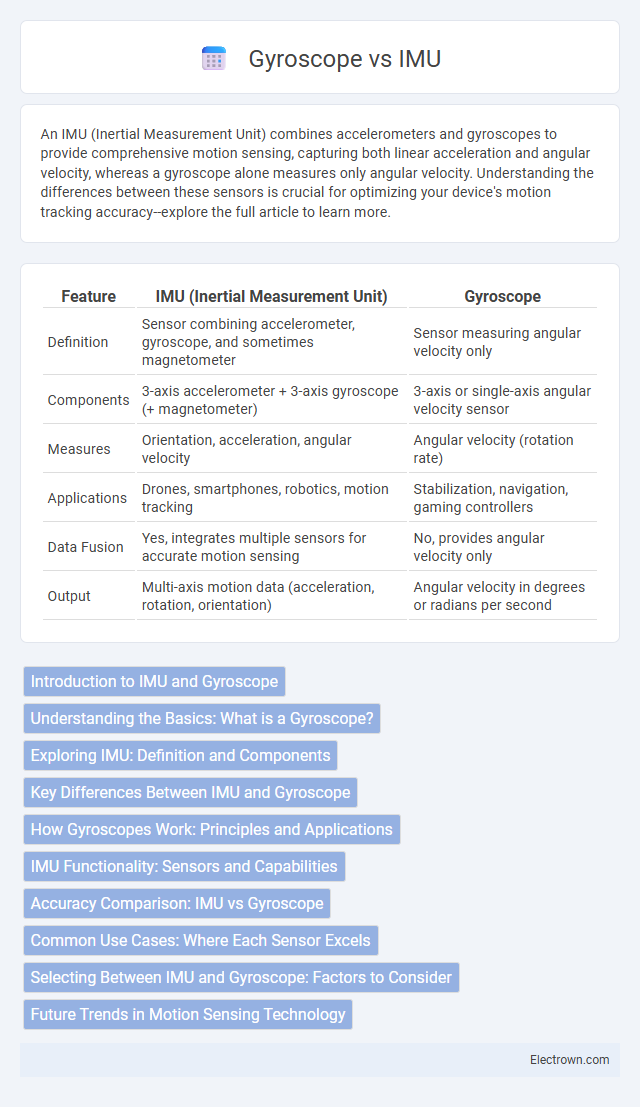An IMU (Inertial Measurement Unit) combines accelerometers and gyroscopes to provide comprehensive motion sensing, capturing both linear acceleration and angular velocity, whereas a gyroscope alone measures only angular velocity. Understanding the differences between these sensors is crucial for optimizing your device's motion tracking accuracy--explore the full article to learn more.
Table of Comparison
| Feature | IMU (Inertial Measurement Unit) | Gyroscope |
|---|---|---|
| Definition | Sensor combining accelerometer, gyroscope, and sometimes magnetometer | Sensor measuring angular velocity only |
| Components | 3-axis accelerometer + 3-axis gyroscope (+ magnetometer) | 3-axis or single-axis angular velocity sensor |
| Measures | Orientation, acceleration, angular velocity | Angular velocity (rotation rate) |
| Applications | Drones, smartphones, robotics, motion tracking | Stabilization, navigation, gaming controllers |
| Data Fusion | Yes, integrates multiple sensors for accurate motion sensing | No, provides angular velocity only |
| Output | Multi-axis motion data (acceleration, rotation, orientation) | Angular velocity in degrees or radians per second |
Introduction to IMU and Gyroscope
An IMU (Inertial Measurement Unit) combines multiple sensors, including gyroscopes and accelerometers, to measure velocity, orientation, and gravitational forces. A gyroscope specifically measures angular velocity, capturing rotational motion around an axis. Your choice depends on whether you need comprehensive motion tracking from an IMU or precise rotational measurement from a gyroscope.
Understanding the Basics: What is a Gyroscope?
A gyroscope is a sensor that measures angular velocity or rotational motion, essential for detecting changes in orientation. Unlike a standalone gyroscope, an Inertial Measurement Unit (IMU) combines gyroscopes with accelerometers and sometimes magnetometers to provide comprehensive motion tracking. Your device's navigation and stabilization systems rely on these measurements for accurate positioning and movement analysis.
Exploring IMU: Definition and Components
An Inertial Measurement Unit (IMU) integrates multiple sensors, including gyroscopes and accelerometers, to measure and report a device's specific force, angular rate, and sometimes magnetic field. The gyroscope within the IMU specifically tracks angular velocity, offering precise rotational motion data essential for navigation, stabilization, and motion tracking. Understanding your IMU's composition helps optimize its applications in robotics, aviation, and smartphone technology.
Key Differences Between IMU and Gyroscope
An Inertial Measurement Unit (IMU) integrates multiple sensors including gyroscopes, accelerometers, and sometimes magnetometers, offering comprehensive motion and orientation data. In contrast, a gyroscope is a single sensor that measures angular velocity along one or more axes, providing rotational rate but lacking linear acceleration information. IMUs deliver complete spatial awareness for navigation and stabilization systems, while gyroscopes primarily detect rotation, making IMUs essential for advanced applications like drone flight control and augmented reality.
How Gyroscopes Work: Principles and Applications
Gyroscopes operate based on the principles of angular momentum, utilizing a spinning rotor to measure orientation and angular velocity accurately. These sensors detect changes in rotation by maintaining the direction of their spin axis, enabling precise tracking in applications such as navigation systems, robotics, and motion sensing in smartphones. The core technology behind gyroscopes ranges from mechanical spinning wheels to modern MEMS (Micro-Electro-Mechanical Systems) devices, offering compact, reliable solutions for real-time rotation measurement.
IMU Functionality: Sensors and Capabilities
IMU (Inertial Measurement Unit) integrates accelerometers, gyroscopes, and sometimes magnetometers to measure linear acceleration, angular velocity, and orientation in 3D space, providing comprehensive motion tracking. Gyroscopes alone detect angular velocity, offering crucial but limited rotational data without linear movement detection. Your choice between an IMU and a standalone gyroscope depends on the need for multidimensional motion sensing versus simple angular rate measurement.
Accuracy Comparison: IMU vs Gyroscope
IMUs provide higher accuracy than standalone gyroscopes by combining gyroscope, accelerometer, and sometimes magnetometer data to correct drift and improve orientation estimation. Gyroscopes measure angular velocity alone, resulting in more drift and less precise long-term accuracy without external reference. Your applications demanding precise motion tracking benefit significantly from using an IMU over a simple gyroscope.
Common Use Cases: Where Each Sensor Excels
IMUs (Inertial Measurement Units) excel in applications requiring comprehensive motion tracking by combining accelerometers, gyroscopes, and sometimes magnetometers, making them ideal for drone navigation, robotics, and virtual reality systems. Gyroscopes alone provide precise angular velocity measurements, which are crucial in stabilizing video cameras, smartphone orientation, and automotive stability control. While gyroscopes deliver accurate rotation data, IMUs offer a more holistic approach by integrating multiple sensors to capture both rotational and linear motion, enhancing performance in complex environments.
Selecting Between IMU and Gyroscope: Factors to Consider
Selecting between an IMU (Inertial Measurement Unit) and a gyroscope depends on application requirements such as motion tracking precision, number of sensors needed, and cost constraints. An IMU integrates a gyroscope, accelerometer, and sometimes a magnetometer, offering comprehensive orientation and acceleration data, ideal for robotics, drones, and augmented reality. In contrast, a standalone gyroscope provides only angular velocity information, suitable for simpler stabilization or rotation sensing tasks where size and power efficiency are priorities.
Future Trends in Motion Sensing Technology
Future trends in motion sensing technology highlight the integration of IMUs (Inertial Measurement Units) with advanced gyroscopes to enhance accuracy and reduce drift in applications such as autonomous vehicles and wearable devices. Sensor fusion algorithms combining accelerometers, gyroscopes, and magnetometers allow your systems to achieve real-time precise orientation and movement tracking. Innovations in low-power MEMS gyroscopes and AI-driven calibration methods will further push the limits of motion sensing in robotics, AR/VR, and healthcare.
IMU vs Gyroscope Infographic

 electrown.com
electrown.com